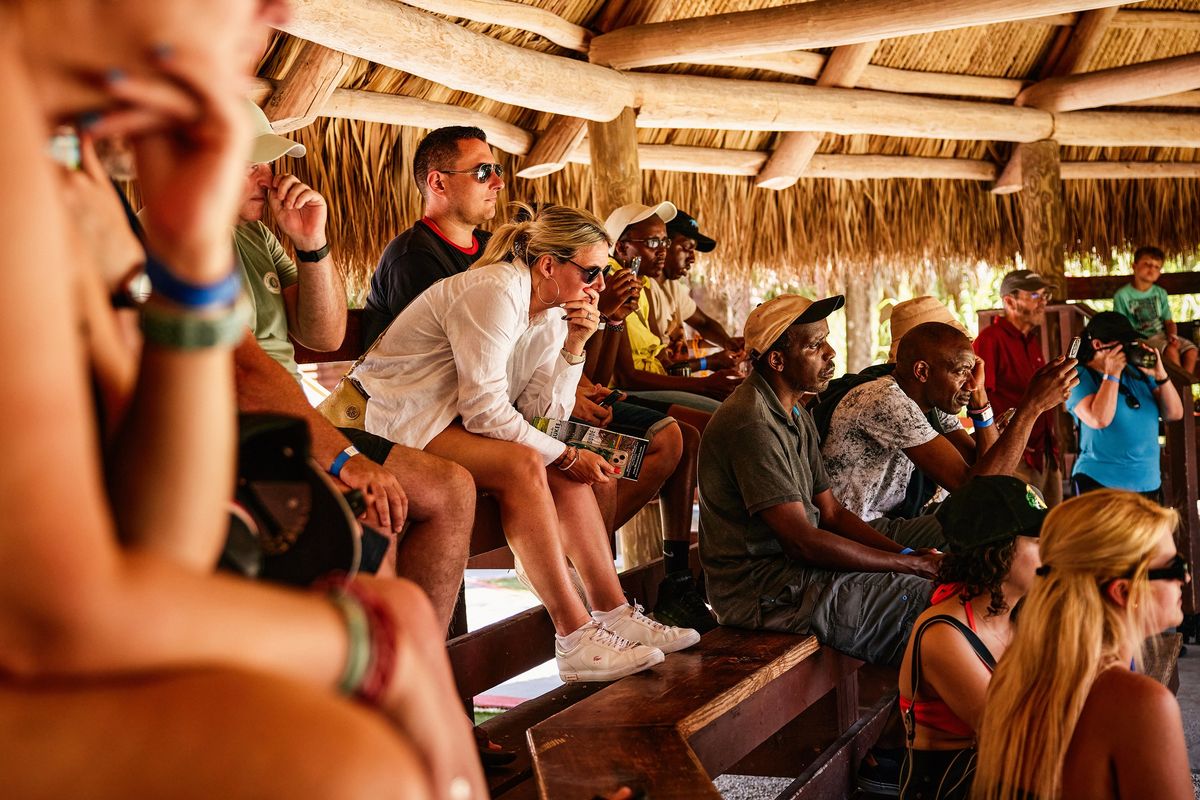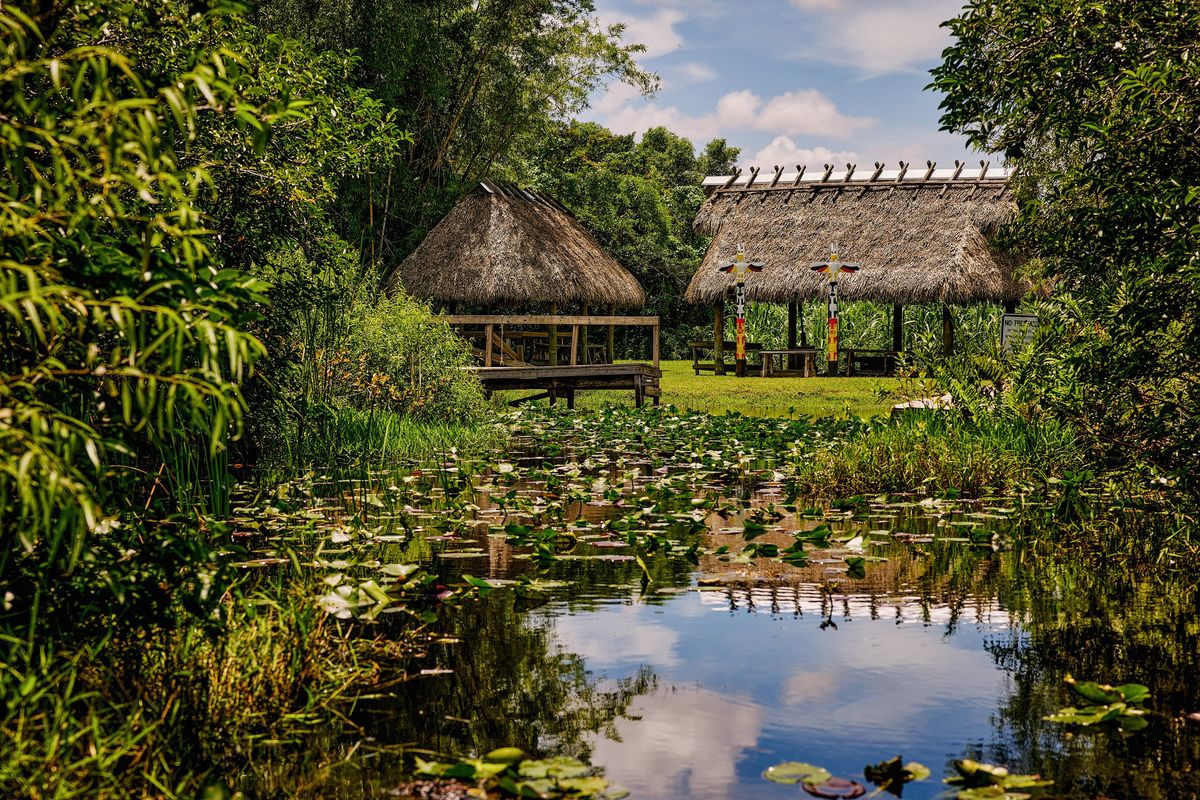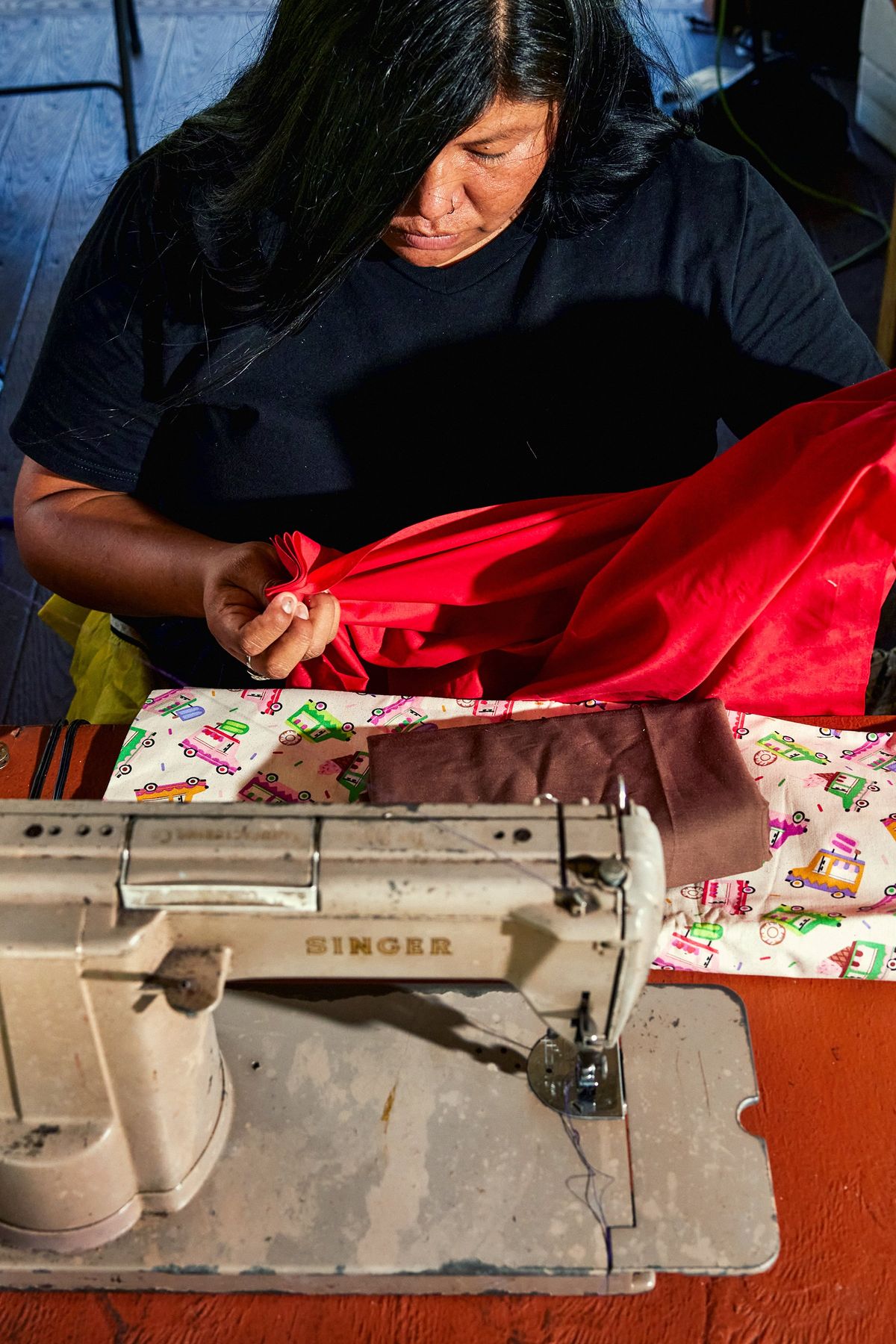Stepping into a hidden world in the Everglades
The tree island where William Buffalo Tiger, the first elected chairman after federal recognition in 1962, once lived on the Miccosukee Indian Reservation, Fla., June 22, 2024. Islands deep in the Everglades protected the Miccosukee and other Native Americans from U.S. troops during the Seminole Wars of the 1800s – today, visitors can take Native-led tours of the islands. (New York Times)
Deep within the seemingly endless saw-grass marshes of the Florida Everglades, I found myself standing on an unexpected speck of dry land on a bright spring day. The boat ride to this spot had fully exposed my tour group to the blustery wind and midday sun, and the island, by contrast, felt lush and welcoming, ringed by trees that cast shadows and tempered the gusts and insulated us from the elements beyond.
Betty Osceola, a member of the Miccosukee Tribe whose salt-and-pepper hair was pulled back in a ponytail, ushered our group into the shade of a palm-thatched structure called a chickee. “These are the traditional homes of the Miccosukee people,” she announced. She spoke slowly and deliberately for the sake of her multinational tourists in a voice flecked with her native Elaponke, accentuating key words with hand gestures. Her people once lived on “tree islands” like this one, and they continue to tend their ancestral homes. That morning, she’d lit a fire, and the pit’s smoldering embers made the island feel as if its inhabitants had merely stepped away and might return at any time.
During the Seminole Wars of the 1800s, in which U.S. forces fought to expel tribes from Florida, the Miccosukee and their kin, the Seminoles, eluded capture by hiding on tree islands, which are formed by sediment accumulating in roots. They remained there well into the 20th century, their villages accessible only by canoe until the 1920s.
Unlike those early inhabitants, we had arrived at the island on an airboat. After leaving Osceola’s dock on the mainland, we spent about 15 minutes navigating a labyrinth of shoulder-high vegetation, gawking at the occasional alligator, before reaching an unmarked point in that vast, grassy sea where we veered right into a thicket of willow, and one thatched roof after another came into view. This secluded spot was where William Buffalo Tiger, the first elected chair after federal recognition in 1962, once lived.
Saved by seclusion
The Miccosukee reservation occupies a relatively small corner of the Everglades, 1.5 million awe-inspiring acres of prehistoric swamps, towering pines, tangled mangroves and sprawling marshland.
On the 90-mile drive southeast from my home in Fort Myers, I followed the old Tamiami Trail (U.S. 41) to the reservation, about 40 miles west of downtown Miami and 70 miles east of downtown Naples. This century-old highway connecting the Atlantic and Gulf coasts of Florida was rendered obsolete when the Alligator Alley stretch of Interstate 75 opened in 1968. Today, the Tamiami Trail is the domain of hikers and campers heading to Big Cypress National Preserve, motorcyclists on weekend rides and road-trippers looking for a taste of old Florida.
Despite my 25 years of living in the state and numerous trips to the Everglades, I had never ridden in an airboat and knew little about the Miccosukee, a quiet tribe of roughly 600 members. As we cut through the marsh, I imagined our airboat as a child’s toy – a speck of humanity in all that water, dwarfed by an endless sky. How could anyone survive in such a place?
Seclusion had saved the Miccosukee, and that legacy persists. “We really were the most secretive tribe,” said 33-year-old Troy Sanders, a guide at the Miccosukee Indian Village, a tribal-run cultural center just off the Tamiami Trail. After the final Seminole War ended in 1858, the U.S. government “kind of forgot” about surviving tribal members, leaving them to the tree islands. Sanders, wearing red, yellow, white and black beads, the tribe’s traditional colors, pointed to a black-and-white aerial photo of a village, a blip of civilization on a saw-grass sea. “Picture one family here, and one family somewhere out there,” he said, gesturing to the space beyond the frame. “Even within ourselves we were very isolated.”
Arts, crafts and alligators
There are two main ways for visitors to learn about the tribe: through Indigenous-run airboat companies like Buffalo Tiger Airboat Tours, owned by Osceola, and at the Miccosukee Indian Village, about 6 miles away from her dock, which features an indoor museum, an outdoor replica village and demonstration area, and an alligator sanctuary.
Because the group airboat tours are relatively short – Osceola’s lasts 45 minutes (adults, $50) – you might start a day trip at the Village, open year-round Wednesdays through Saturdays (adults, $27.95). Gaining baseline historical knowledge here will lend deeper appreciation of the tree islands and the tribe’s adaptation to them once you’re on the water. Osceola’s company is one of several tour operators, including Tigertail Airboat Tours (adults, $60 for a one-hour tour), and a tribal-run enterprise affiliated with the Village (adults, $40 for a 40-minute tour). All three offer longer, more in-depth private tours.
The Village has the air of an old Florida roadside attraction, subdued and in need of some facility updates. As I wandered it while waiting for a group tour, I gleaned some insights, mainly from interpretive panels in the museum. The demonstration village lacks signage, and the craftspeople showing beadwork, wood carving and sewing were not particularly talkative until Sanders, the guide, showed up, facilitated conversation and brought the place to life with his passion. “When you start working here, you start to learn about yourself,” Sanders recalled another tribal employee telling him when he began. “And nothing could be more true than that.”
When the Tamiami Trail opened in 1928, many of the Miccosukee traded the wilderness for the roadside, building new villages, selling traditional crafts, offering boat tours and even charging admission to travelers curious for a glimpse at how they lived. “Indian Village” signs began to pop up along the highway, and remain there even today. Sanders’ great-grandfather opened this site in the 1950s, converting his clan’s village into a tourist attraction to open a window into his people’s world.
Group tours include a walk through the village and the museum, which features historic photos and life-size dioramas. Along the way, guides like Sanders, a gifted storyteller, dispel Hollywood-inspired myths and explain the tribe’s distinct housing, matrilineal culture and crafts such as sewing, which advanced from simple tunics to dazzlingly intricate patchwork once Miccosukee women acquired sewing machines.
I nearly skipped the alligator demonstration, the highlight of the day for many other guests, particularly those with children. Having seen gators many times, I was no longer enthralled by the reptiles, and I feared the show might be gimmicky. But it was not.
After a presentation in English and Spanish on the importance of gators for food, clothes, tools and trade, Jayke Vasallo and Jessie Cottone, the handlers, showed how a lone hunter would have captured his prey in the wild. As Vasallo narrated, Cottone – a rare female handler – straddled the gator from behind, arched its back, clamped its jaws and used her chin like a vise to secure the beast’s mouth, freeing her hands to mimic tying a rope around it.
The demonstration captivated Richard and Rocio Espinal, both 53, and their 9-year-old son, Richard, who were visiting from Miami. The elder Richard Espinal abandoned his seat for an up-close view at the rail. Both of us jumped when Cottone teased the audience by waving her hand in front of the gator’s open jaw and shouting as if she’d been bitten. After the show, the Espinals talked about what had brought them to the Village.
“I wanted to know about the Indians who were original to this land,” said Rocio Espinal. The first time she’d heard of the tribe was when she saw a sign for the Miccosukee-run golf club in Miami, and it inspired her to want to learn more. “We were very curious about their lives,” she said.
Fighting the floods
Deep out in the marsh on Buffalo Tiger’s island, Osceola was showing our group how this tiny dot of dry land could provide a bounty that sustained a multigenerational family of 10 to 15 people. “They put the meat up here like a smokehouse,” she explained, gesturing to the chickee’s rafters. “The fire would cure the meat, and the family would use what it needs.” She led us along a short boardwalk, pointing out medicinal plants like willow, whose bark contains a compound similar to aspirin, and edible, wild swamp apple and cocoplum fruits.
Osceola also offered insights into how the Miccosukee live today. Her people no longer dwell on the tree islands, she explained, but use them for ceremonies and to grow crops like pumpkin and corn. She has a modern house with a traditional thatched roof along the Tamiami Trail.
At the tour’s start, Osceola introduced herself merely as “guide,” but I knew otherwise. Besides owning the tour company, Osceola is a tribal judge and a well-known activist for the environment, a subject she brought up during the tour.
Only about 30% of the tree islands that once harbored her people remain, she told us. I wanted to know more, so after the excursion, I asked her why so many had disappeared.
More than a century of dredging, ditching and developing the Everglades has altered the natural flow of water through the southern half of the state, she said. Today, the Everglades – which has shrunk to about half of its historical footprint – is artificially managed through pump stations, levees and other infrastructure. But Osceola said current water management practices allow too much water to accumulate on the tribe’s land, resulting in extended periods of flooding that are killing the tree islands and the wildlife they support. “That tree island we were just on was underwater for six months,” she said. An unusually wet winter had made the situation even worse. Ongoing restoration efforts could someday address the floods, but the process is slow.
The tribe appears to be gaining influence – and a voice – in Everglades restoration and management decisions. For years, Osceola said, members had stood by quietly as policymakers, scientists and engineers made decisions that affected tribal land. “In our culture, if people don’t agree with something or they’re upset about something, we give you the cold shoulder. We don’t say anything,” she said. “But we’re learning that silence is acquiescence.”
The stakes are high, and until I stood with Osceola on Buffalo Tiger’s island, I had never seen the Glades this way: not as an intimidating wilderness to be tamed, as many Floridians do, but as the Miccosukee do – as a home.
“I would hope guests learn to love the Everglades – and leave with some appreciation of the environment,” Osceola said, adding with a quick grin, “That’s in addition to getting their picture with an alligator.”
This article originally appeared in The New York Times.












